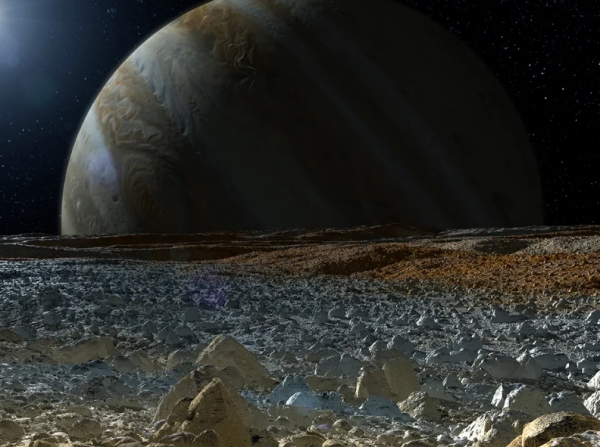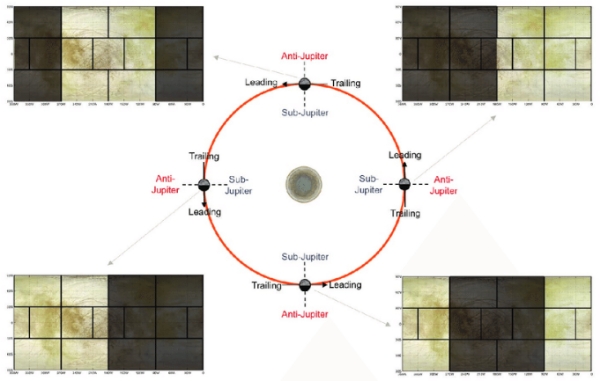Juno has worked wonders for our knowledge of Jupiter, but we continue to rely on Hubble observations and still helpful imagery from Galileo as we study the giant planet’s intriguing moon Europa, anticipating the arrival of Europa Clipper and the European Space Agency’s Jupiter Icy Moons Explorer (JUICE) at the end of the decade. The great question is whether life can exist beneath the ice, and the evidence of plume activity, first found in 2013 in Hubble data, is encouraging in some ways more than others. A mission to Saturn’s moon Enceladus can rely on geysers in a particular place — the Tiger Stripes at the south pole — and on geysers that are frequent. At Europa, predicting where and when a plume will burst forth is all but a black art. How do we sample a Europan plume?

Image: Will we one day see Europa through the eyes of a (well-shielded) lander? Credit: NASA.
While contemplating that question, we push ahead with other analyses that help us characterize this unusual place. A team led by Lorenz Roth (KTH Royal Institute of Technology, Space and Plasma Physics, Sweden) has produced evidence from Hubble that a persistent fraction of water vapor exists within Europa’s atmosphere, what little of it there is (this is an atmosphere with one-billionth the surface pressure of the atmosphere on our planet). Here we are talking not about plumes but processes including sublimation, where surface ices transition directly to vapor. It’s a finding that feeds into planning for those upcoming Jupiter missions and also informs us more deeply about how icy moons react to this high radiation environment.
The paper on this work, which appeared in Geophysical Research Letters (citation below), reinforces the contrast between plume activity and persistent vapor:
A key finding of this study is the consistency in the detection of the reduced oxygen emission ratio on the trailing hemisphere disk center and the overall stability of the ratio profiles in all images with similar geometry. In particular, the oxygen emission ratios in center and limb regions in the four trailing side visits, which were obtained in 1999, 2012, and 2015 and are all consistent within uncertainties. This means, they are diagnostic for persistent atmospheric properties, in stark contrast to the apparent transient nature of detected features that were interpreted to relate to H2O plumes (Paganini et al., 2019; Roth et al., 2014b).
The transition of ice to water vapor raises questions. Water vapor on Europa seems to be limited to the moon’s trailing hemisphere, the part of the moon that remains opposite to its direction of motion along its orbit. The cause of the asymmetry between leading and trailing hemispheres is intriguing given that we find the same phenomenon on Ganymede as well.
The paper also notes that the ratio of H2O relative to O2 is similar on the trailing hemispheres of both Europa and Ganymede. I should note before going further that the detection of water vapor on Ganymede came from Roth’s use of the technique he here uses on Europa, as discussed in Nature Astronomy earlier this year.

Image: Since Europa is tidally locked, Europa’s terrain maintains the same orientation relative to Jupiter (center image). The notional Jupiter centered plot viewed from Jupiter’s north pole in the rotating frame with the y-axis points to the Sun, z-axis normal to the Jupiter orbit plane, and x-axis completing the right rule. Also shown are maps of Europa showing the fourteen roughly equal-area regions delineated by the Europa Science Definition Team (SDT) and the surface illumination around Jupiter. Credit: Lam et al., from “A Robust Mission Tour for NASA’s Planned Europa Clipper Mission,” 7 January 2018 / AIAA Space Flight Mechanics Meeting 2018.
How fully do we understand the production of water vapor in the Europan environment? Consider this snip from the paper. It points not only to sublimation, but also to the phenomenon known as ‘sputtering,’ in which surface particles are bombarded by energetic plasma. Sputtering is considered an alternative source for at least some of the H2O found on Europa’s trailing hemisphere, especially given the modeling of plasma discussed in this paper:
The trailing hemisphere [of Europa] also coincides with the plasma upstream hemisphere, where most of the thermal plasma impinges on Europa’s surface according to modeling (Cassidy et al., 2013; Pospieszalska & Johnson, 1989). In addition, the sputtering yield (amount of neutrals ejected per incident charged particle flux) also increases with surface temperature (Famá et al., 2008), further favoring the trailing hemisphere independent of the distribution of the incident flux…. For both sources [Europa and Ganymede], however, modeled H2O abundances are often significantly lower than our derived value on the trailing side.
Roth’s datasets were produced in Hubble ultraviolet observations using the instrument’s Space Telescope Imaging Spectrograph (STIS). There is still much for the next two spacecraft to investigate in terms of water vapor at Europa as we examine the difference between leading and trailing day-side hemispheres, but the exact mechanism remains unresolved:
Putting the main results in a nutshell, oxygen emission ratios found in HST observations suggest a persistent H2O atmosphere above Europa’s trailing hemisphere, but the source of the water vapor cannot [be] unambiguously identified.
The paper is Roth, “A Stable H2O Atmosphere on Europa’s Trailing Hemisphere From HST Images,” Geophysical Research Letters Vol. 48, Issue 20 (28 October 2021). Published online 13 September 2021. Full text. The paper on Ganymede is Roth et al., “A sublimated water atmosphere on Ganymede detected from Hubble Space Telescope observations,” Nature Astronomy 5 (26 July 2021), 1043-1051 (abstract),



I think an intermittent phenomenon lile that rrally needs a base on callisto where a human crew can operate remote control probes.
There is H.O.P.E. for such a mission ;-) it does require that people set aside their irrational fear of nuclear power. Anything that goes significantly beyond Mars orbit requires nuclear anyway. I used to live less than 600 feet away from a running nuclear reactor for months (87 days straight was the longest undersea mission for me) at a time and I dont glow in the dark. Its a good way to generate power. :)
https://ntrs.nasa.gov/api/citations/20030063128/downloads/20030063128.pdf
Why not a remotely operated base on Callisto launching probes in that system? Organic humans cost a lot more to maintain in space, and robotics and AI are only getting better each day. Plus until they become sentient, we don’t need to worry about their psychological needs being hundreds of millions of kilometers or more living and working in space for years.
China is already looking at setting up a fully automated base on Luna.
That “remote operation” might be more of a “remote management” as the robots are likely to be a lot more autonomous by then. Think more of Asimovian robots but without a humanoid form.
I think we are already getting to the point where we can transmit an order to a rover to “go to that point over to position X” and let it plan and do the operation rather than planning it out from mission control and transmitting the detailed instructions.
We will want our robots to carry out orders just as we do with people, IOW we treat our robots as workers (just as ?apek intended by using the word). Initially they may be like unskilled workers but with time they will become highly skilled at tasks, and those skills can be shared with other robots, rather than learned and trained with humans.
Recall that in Clarke’s 2001: A Space Odyssey that the HAL 9000 computer claimed it was fully capable of carrying out the Jupiter mission (even teh secret one that Bowman and Poole had no knowledge of). Whether that was not just hubris, or whether Clarke and Kubrick intended this, Clarke certainly wrote stories where biological intelligence became embodied in machine bodies and then eventually became incorporeal.
KSR’s Aurora about the failure of a colonization of Tau Ceti due to biology, as well as the failure to maintain the starship’s biosphere for a couple of centuries might be a bit of a downer for those intent on humans becoming interstellar colonists. Had teh ship been filled with robots, the story would have been rather different.
During the Devonian, had the fish become more intelligent and technological, they might have wanted to colonize the land. They would have had to build aquatic habitats with ecosystems to maintain their food and oxygen supply and recycle their wastes. Yet eventually reptiles evolved to colonize the land in almost all environments (the dinosaurs and their avian branch completed that colonization) without needing such technological protection. Humans are in the same position as those Devonian fish, assuming that our position entitles us to colonize space when it should be becoming ever clearer that our machine descendants will be the most adapted to colonizing space.No human has survived more than a year or so in space, wheeas our satellites, and robotic rovers, have operated unprotected in space and on planetary surfaces for many years. Our Voyager space probes are still working (just) after decades in space, their only shortcoming is their dwindling energy supply. How long could they operate if they had a longer lasting energy source?
How long before our robots are longer-lived than the oldest humans, and like Asimov’s robots that survived the many millennia into the universe of the Foundation universe, continue to survive far longer than any terrestrial animal?
Thanks for invoking Clarke; it’s interesting: “All of these worlds are yours. Except Europa. Attempt no landing there.”
I tend to think, like ljk that we are far more likely to set up a base with AI operated equipment only. Humans are costly to keep alive and care for, including their psychological needs. It’s a long way away and so very costly to get humans there as well. I don’t see humans on long term missions about beyond Mars for a long time to come (if ever). At one time I thought it would happen, and it may still, but it’s a very high risk, very expensive project when there is so much more to do.
Yeah, I totally agree. Robot capabilities are routinely hugely overstimated and human surviving hability is grossly understimated, including the psichological factors. Of course, there is the stupid nucleophobia too, although it’s mostly restricted to the western world.
I think they gotten this right, since the plasma hits the trailing hemisphere from ‘behind’ I immediately thought the water vapor would be caused by the plasma in the radiation belts. And the paper concludes this, so it seem very plausible.
Hi
Another very interesting article I sure would like to see a lander at Europa, personally I would have liked to have had it ahead of some of the Mars missions. I’ll be looking forward to the future orbiters which will pave the way for a future lander mission.
Cheers Edwin
NASA flyby of Jupiter’s big moon Ganymede revealed massive unknown craters
By Tereza Pultarova published about 6 hours ago
https://www.space.com/juno-ganymede-moon-flyby-craters-auroras